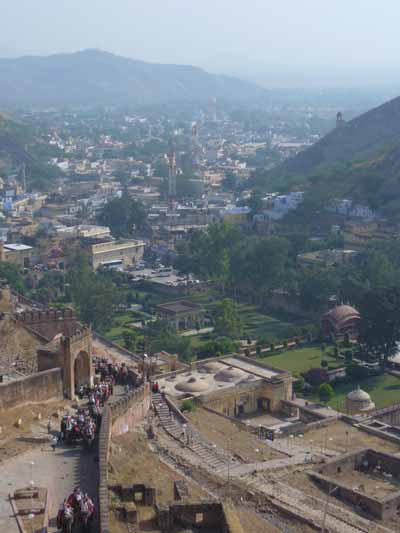India
By Kristin Trapp
India’s
display of urbanism was sometimes harder to witness than others. As I was walking through the dirt streets of
Jaipur
I quickly realized that it was going to be much more difficult to
recognize any
markings or buildings that showed sign of transnational or vernacular
urbanism. To my utter shock and
amazement there was not even a McDonalds, however there were other
international businesses. This place
reminded me greatly of Myanmar
and that really surprised me. I never
thought that a place that is known for its medical advancements could
be this
far behind in its cities. The dimensions
of the cultural flow that had once been so pertinent to my
understanding of
other cities now appear in a completely different manner.
Ethnoscapes and finanscapes will now have a
completely different meaning in this
port. meaning in this
port.
The
excursion that I signed up with through Semester at Sea visited Jaipur,
Agra and a half a day in New Delhi. All of the places we visited were prime
tourist attractions. The ethnoscapes for
all of these cities were easy to identify since ethnoscapes include an
observation of tourists. Tourism plays a
key role in the daily lives of many of the natives of these cities. The vernacular aspects of the cities were
demonstrated at their peak in the areas around the tourist attractions. Vendors literally chased me into the tour bus
demanding that I purchase something from them. I
felt it would be a very challenging place to
travel without some sort of tour guide, but the comforts of traveling
with
Semester at Sea left this as an assumption that I can not prove as true. The majority of the places we visited were
occupied with people that spoke English and in the instance that there
was a
language barrier a tour guide was not far away. Every
stop that we made with the trip was to a picturesque
place and the
feeling that we were not seeing the true “India” was inescapable. Still knowing that there was more to a city
then tourist attractions I wanted to observe some of the buildings that
were in
these cities.
Many of the
buildings that I saw in Jaipur looked dilapidated and structurally
unsound, not
the feel of a transnational city. The
majority of the houses do not have air-conditioning and most of them do
not
even have indoor plumbing. The best
explanation of this is seen in article written by Sudhin Thanawala,
“Slums
Separate Bombay from its Future Struggle Over Plans for Redevelopment
Slows
City’s Progress.” The article mainly
discusses the extent of the poverty in which many Indian families live
in and
their disbelief that their environment will be improved.
Although Thanawala is describing Bombay, may of his points
apply to other Indian cities as well. India’s
population is already quite large and is expected to expand its
population in
the upcoming years. This presents a huge
problem as far a housing is concerned, there just is not enough and as
a result
the already overcrowed slums will be experience new limits. The solution is building apartments for
families in marshlands and while the project is underway families will
live in
free housing. There is still a lot of
controversy over the project but developers are optimistic. The majority of the streets are not paved and
side walks seemed to be non-existent. Cows
were allowed to freely graze, stray dogs ran rampant
through the
streets, definitely not the signs of a global city.
India
was very different from most of the countries that I have visited but
showed
many similarities to Cambodia. The most shocking observation I made was the
complete disregard for one’s necessity to relieve oneself in public,
even the
middle of a crowd street proved to be acceptable. Nothing
but the hotels appeared to be new and
everything felt dirty and dingy.
India
was a
very humbling place to visit. The basic
amenities that the United States
has to offer was greatly missed by me during my very long five days in India. Not being able to drink the water, worry
about diseases and every little bug bite was something that I am not
accustomed
to. The history that India
has is
heartbreaking and the lack of resources for basic supplies was very
troubling. The lack of ability to improve
oneself because of the caste system is very upsetting. I
definitely had an eye opening experience and
upon my departure I missed home in a way I never thought possible.
|

 meaning in this
port.
meaning in this
port.